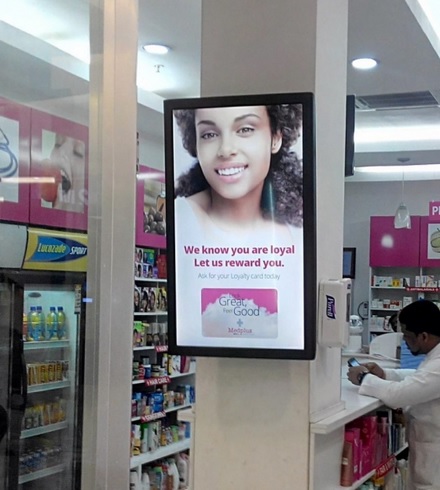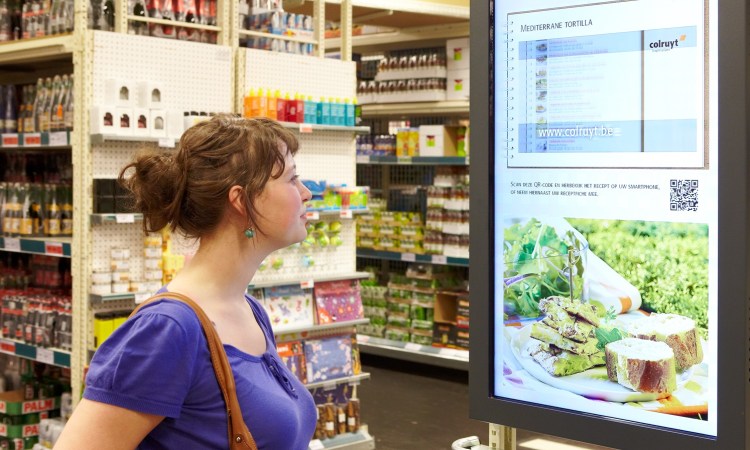There’s a great deal of buzz over the digital out-of-home (OOH) advertising industry. OOH is a form of advertising that reaches consumers when they are outside of their homes, for example, in public places such as billboards or commercial locations and malls. eMarketer projected digital OOH advertising spending would reach $4.5 billion in 2019, up from $2.7 billion in 2014, in the United States alone.
Digital OOH is beginning to look a lot more like online media, with the use of attention metrics. Eye-tracking software and scanning technology make it possible for marketers to see what kinds of ads people are watching and which parts of the screen they’re most drawn to. The technology also makes it possible to target ads to the demographic standing in front of the screen, based on gender and other aspects. Now that it’s possible to track whether or not someone’s paying attention, media buyers are motivated more than ever before.
 Retail checkout lines are the most obvious high-impact placements. When done correctly, there’s potential for a huge message relevance, based on intent, geographic location, and content. When retailers implement this strategy right, customers find the infotainment enjoyable.
Retail checkout lines are the most obvious high-impact placements. When done correctly, there’s potential for a huge message relevance, based on intent, geographic location, and content. When retailers implement this strategy right, customers find the infotainment enjoyable.
Recent studies show these digital signs are 34% more effective at promoting items than their static equivalents. Digital signs can play video and audio, which are better at capturing attention than a static image. The sound and moving images or colors can grab attention, while the storyline or content can hold it.
Millward Brown conducted a study last month on behalf of Impax Media, a developer of digital point-of-sale advertising networks, during a recent store trial. The study found the following:
Checkout lines are the most hated part of shopping
69% of customers surveyed said they were either extremely or somewhat frustrated with the long checkout lines. This answer received the most responses, with pricing too high and out of stock being the next two, coming in at 66% and 65% respectively.
Interestingly, digital signage at grocery stores reduced the perceived wait time by more than a third (35%). And 84% of customers said that watching content on the displays helped the time spent waiting in the checkout line pass more quickly.
Most customers are interested in watching screens
70.2% of customer surveyed said they would watch the screens when in the checkout line. Another 15.7% said they weren’t sure, however – that means an astonishing 85.9% of grocery store shoppers are potentially interested in watching the screens.
85% of shoppers who shopped in stores where the screens were installed said the screens were entertaining and pleasant to watch. 78% of them said the screens caught their attention, and 70% said the content was useful, while 62% called it interesting.
Nearly half of customers are more likely to shop at stores with screens
40% of customers said they’d be more likely to shop in grocery stores that have video screens in the checkout lane. But simply using the screens anywhere in-store could increase customer loyalty. Shoppers said they are most interested in seeing information like:
-
What’s on sale – 76%
-
Weather – 75%
-
Upcoming special in-store events – 69%
-
New services in the store – 65%
-
Local community events – 64%
-
Recipe ideas – 63%
Customers were less interested in things like travel pictures, home decorating ideas, sports highlights, and consumer electronics. However, since this is based on the grocery store audience, this type of content could do well in other retail outlets. For instance, sports highlights could do well in a sporting goods store, while consumer electronics news could do well in stores like Best Buy.
A turn-key digital video platform at point-of-sale is a wonderful way for grocery stores and other retailers to generate more revenue. 60 seconds of airtime for five retailer-branded spots is valued at $5,100 per month, per store — $61,440 a year. All revenue generated from market development funds and branded content remains with the retailer. The retailers pay a monthly per-screen fee, while the platform provider handles everything – even the retailer branding of non-retailer content.
Beyond grocery stores, these screens could work in any retail establishment. If customers are open to it, and you can help reduce the pain of waiting in the checkout line while earning more revenue, why not?
Joe Liebkind is a Berlin-based writer. He has worked with startups in sales and marketing roles in Berlin and New York, including at Oktopost and Socedo.


